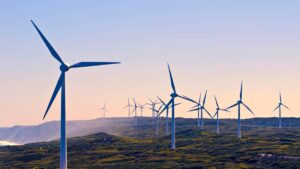Green Energy: Construction jobs in renewables two-thirds down on 2018, says Clean Energy Council

Pic: Vertigo3d / E+ via Getty Images
The pace of construction in Australian renewable energy is declining in 2021 despite global momentum for energy transition technologies.
The Clean Energy Council claims some 2700 jobs have been lost to the sector since 2018, with just 1300 peak construction employees in renewable energy projects during the first two quarters of 2021, down 67.5% on three years ago.
Three solar farms – Woolooga and Edenvale in Queensland and West Wyalong in New South Wales – reached financial close in the June quarter, with the 350MW of capacity added in Queensland a record.
An average of some 432MW have been added in the first two quarters of 2021, 29 per cent lower than 2020 and 70 per cent down on the same period in 2018.
The handbrakes have come down fasted on wind energy, with the CEC saying only one development has reached financial close in 18 months, down from 17 across 2018.
CEC CEO Kane Thornton blamed ‘unhelpful government policy interventions’ for discouraging investment in the sector.
“This is a significant loss for the Australian economy at a time when it’s critical to get our nation moving again,” he said.
“This represents a major loss of jobs in critical areas such as civil and electrical engineering, project management and logistics as well as the associated jobs in local communities supporting these large construction projects.
“Investment in clean energy has fallen to levels not seen for several years as a result of the increased risks facing investors, including from grid connection and network constraints as well as the ongoing unpredictable and unhelpful government policy interventions and market reforms.”
The latest bugbear of the CEC and its constituents is the recommendation by the Energy Security Board of a physical capacity mechanism supported by ScoMo’s Energy Minister Angus Taylor that, according to opponents, may see coal and gas generators stay in the system past the date open market conditions would render them unviable.
The CEC has also called on the Australian Government, which faced criticism from environmental groups for its response to the IPCC’s damning Sixth Assessment Report, to set more expansive carbon reduction targets.
“While the competitiveness of renewable energy and energy storage continues to improve, without the necessary policy and regulatory certainty, investors will continue to face materially higher risks in Australia than the many other countries who are unequivocally focused on accelerating clean energy investment,” Thornton said.
US to expand renewable energy, but coal to rise in near term as gas prices rise
If Australia’s uptake of renewables – now around a quarter of the national grid – has hit some roadblocks, how is the world’s biggest economy faring?
According to Commbank analyst Vivek Dhar renewables outside hydropower will rise steadily to supply 16% of electricity generation in the US by 2022, up from a projected 14.5% this year and 12.5% in 2020.
“Both wind and solar power capacity will contribute to the gains in renewable power generation in 2021,” Dhar said in a note this morning. “But in 2022, solar capacity additions are expected to exceed wind.”
“The slower growth in wind power capacity is linked to the expiration of the production tax credit.”
Gas generation in the US will also fall from 40.3% to 36.9% in 2021, driven by high gas prices before lifting again to 37.9% in 2022.
Coal power, however, is expected to increase its share of generation in the States even further in 2021 from 19.3% to 22.6% before falling to 20.3%.
Nuclear power is set to decline with reactor retirements outpacing new commissioning, although the Biden administration has previously stated its support for keeping nuclear in the grid in net zero scenarios.
The US grid is due for a radical shake-up with President Joe Biden pledging to cut carbon emissions by 50-52% from 2005 levels by 2030.
That would require 80% of power to be emissions-free by 2030, with Biden aiming to hit net-zero emissions from power generation by 2035.
Dhar said this would require a dramatic reduction in gas and coal fired generation in the coming years.
“The plan is very ambitious and would need significant innovation and technology breakthroughs over the next decade,” he said.
“Battery storage and grid investments would be essential for the goal to be achieved.”
“A number of US utilities have expressed concern that reliability and affordability may be compromised in the pursuit of decarbonising the power sector by 2035.”
“While these concerns have credibility, long-term forecasts are prone to underestimating the changes in technology and policies. The level of CO2 emissions from US electricity generation in 2020 for example was about half that projected in 2005.”
“And that’s because energy efficiencies lowered electricity demand 24% below projections, renewables grew 79% more than anticipated and coal and oil power generation plummeted 70% more than forecast in 2005.”
Related Topics
UNLOCK INSIGHTS
Discover the untold stories of emerging ASX stocks.
Daily news and expert analysis, it's free to subscribe.
By proceeding, you confirm you understand that we handle personal information in accordance with our Privacy Policy.








